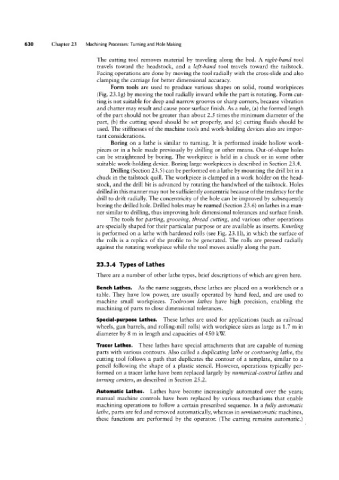Page 649 - Manufacturing Engineering and Technology - Kalpakjian, Serope : Schmid, Steven R.
P. 649
0 Chapter 23 Machining Processes: Turning and Hole Making
The cutting tool removes material by traveling along the bed. A right-hand tool
travels toward the headstock, and a left-hand tool travels toward the tailstock.
Facing operations are done by moving the tool radially with the cross-slide and also
clamping the carriage for better dimensional accuracy.
Form tools are used to produce various shapes on solid, round workpieces
(Fig. 23.1g) by moving the tool radially inward while the part is rotating. Form cut-
ting is not suitable for deep and narrow grooves or sharp corners, because vibration
and chatter may result and cause poor surface finish. As a rule, (a) the formed length
of the part should not be greater than about 2.5 times the minimum diameter of the
part, (b) the cutting speed should be set properly, and (c) cutting fluids should be
used. The stiffnesses of the machine tools and work-holding devices also are impor-
tant considerations.
Boring on a lathe is similar to turning. It is performed inside hollow work-
pieces or in a hole made previously by drilling or other means. Out-of-shape holes
can be straightened by boring. The workpiece is held in a chuck or in some other
suitable work-holding device. Boring large workpieces is described in Section 23.4.
Drilling (Section 23.5 ) can be performed on a lathe by mounting the drill bit in a
chuck in the tailstock quill. The workpiece is clamped in a work holder on the head-
stock, and the drill bit is advanced by rotating the handwheel of the tailstock. Holes
drilled in this manner may not be sufficiently concentric because of the tendency for the
drill to drift radially. The concentricity of the hole can be improved by subsequently
boring the drilled hole. Drilled holes may be reamed (Section 23.6) on lathes in a man-
ner similar to drilling, thus improving hole dimensional tolerances and surface finish.
The tools for parting, grooi/ing, thread cutting, and various other operations
are specially shaped for their particular purpose or are available as inserts. Knurling
is performed on a lathe with hardened rolls (see Fig. 23.1l), in which the surface of
the rolls is a replica of the profile to be generated. The rolls are pressed radially
against the rotating workpiece while the tool moves axially along the part.
23.3.4 Types of Lathes
There are a number of other lathe types, brief descriptions of which are given here.
Bench Lathes. As the name suggests, these lathes are placed on a workbench or a
table. They have low power, are usually operated by hand feed, and are used to
machine small workpieces. Toolroorn lathes have high precision, enabling the
machining of parts to close dimensional tolerances.
Special-purpose Lathes. These lathes are used for applications (such as railroad
wheels, gun barrels, and rolling-mill rolls) with workpiece sizes as large as 1.7 m in
diameter by 8 m in length and capacities of 450 kW
Tracer Lathes. These lathes have special attachments that are capable of turning
parts with various contours. Also called a duplicating lathe or contouring lathe, the
cutting tool follows a path that duplicates the contour of a template, similar to a
pencil following the shape of a plastic stencil. However, operations typically per-
formed on a tracer lathe have been replaced largely by numerical-control lathes and
turning centers, as described in Section 25.2.
Automatic Lathes. Lathes have become increasingly automated over the years;
manual machine controls have been replaced by various mechanisms that enable
machining operations to follow a certain prescribed sequence. In a fully automatic
lathe, parts are fed and removed automatically, whereas in serniautoinatic machines,
these functions are performed by the operator. (The cutting remains automatic.)

